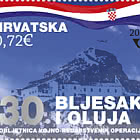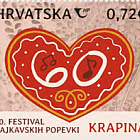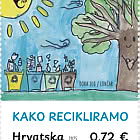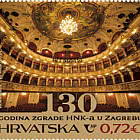Motif: The official coat of arms of Lastovo in the Dubrovnik Republic with St. Cosmas and St. Damien, patron saints of Lastovo, and a cartographic display of the island The Statute of Lastovo was codified almost seven hundred years ago to the day, during a public assembly in Lastovo on 10 January 1310. The practice of codifying statutes in Dalmatia was implemented in all of its communes from the 13 century and further on, and in Western Europe the process began only one century earlier. It primarily meant defining the legal operations and obligations among the people and the overall functioning of the more or less, depending on the area, autonomous commune structure. It also included the involvement of that very area in the process of legal and cultural improvement, which went hand in hand with the European Medieval civilization, and which put an emphasis on the legal structure and protection of every individual. In terms of the Statue of Lastovo and its genesis one should point out that it consists of a series of provisions which had been traditionally implemented on the island of Lastovo and which were drawn up and modified by adding new provisions in 1310 for the purpose of defining the legal structure of the Medieval Lastovo commune under Dubrovnik rule. The awareness of preserving one’s legal tradition, as well as the written culture and the importance of the written word, have resulted in the fact that, compared to other islands, the largest number of Medieval and Early Modern historical sources have been preserved on the island of Lastovo. The island owes that primarily to the early statutory structure of the commune and the resulting, highly developed notaryship, which records we have been continuously monitoring over the centuries. These are the very sources we are using to learn about the real application of statutory provisions which were not just meaningless words put on paper but a good combination of tradition and introduction of new rules witnessed in other communes, all with the objective of establishing better management of the island itself which is, clearly, limited in terms of space. It is, therefore, quite understandable that, over the centuries, the Statute had been symbolizing the heart of the Lastovo’s autonomy. From the middle of the 13th century Dubrovnik ruled over Lastovo which, in political terms, voluntarily surrendered to it and became its principality. The Dubrovnik commune used this position to promise the people of Lastovo “that it will keep all their old customs intact”. After the gathering of the old Croatian legal institute called zbor (assembly) in front of the Lastovo parish church of St. Cosmas and St. Damien and having collected the old Lastovo traditional norms into one code, the Dubrovnik count Bartul Gradenigo approved the Statute of Lastovo. Dubrovnik’s influence is visible in the Statute itself with certain norms from the Statute of Dubrovnik enlisted into its corpus. The Statute of Lastovo was written in Italian with certain subsequent provisions written in Latin language. The language of the Statute certainly should not imply that there are people other than Croats living on the island. The Croatian features of the island are primarily indicated by the anthroponyms and toponyms as well as the Croatian terms expressed in Italian (sboro for zbor, gomna for gumno, etc). The Statute consists of 189 chapters which regulate the functioning, the various duties and the relations within the commune in legal terms. The document begins with a provision from the Statute of the town of Dubrovnik, later on defining it as a book of provisions and customs of the Community and Commune of the island of Lastovo. In legal terms, the structure of the Statute covers the individual’s rights and family law, as well as property (real, obligatory and hereditary) and criminal and procedural law. According to the provisions of the Statute, the basic communal management consists of the Assembly and the Council, the count and the judges, the chamberlain and the chancellor as well as other services (the guards, the crop guards, the curriers etc.). The Statute determines the obligations and the rights regarding the Church and the commune, which is well-witnessed in the examples of a few provisions based on exceptionally lay perceptions of how the commune is organized. According to a prominent Croatian legal historian Antun Cvitanić, who is competent to say the following, the Statute of Lastovo and the Lastovo communal structure are “proof of wisely preserving the tried and tested traditional values, but also of accepting foreign, already tested civilization accomplishments among the Croatian people." Until this day, the Statute of Lastovo was published several times and one of the publications includes the valuable series of historical and legal monuments published by the Croatian Academy of Sciences and Arts (Monumenta historico-juridica Slavorum Meridionalium, vol. VIII) titled Knjiga o uredbama i običajima skupštine i obćine otoka Lastova (Zagreb, 1901). This exemplary publication was put together by Frano Radić. The new edition of the Statute of Lastovo with the original in Italian language, Croatian translation and comments and legal and historical studies was published in Split in 1994 with Antun Cvitanić and Josip Lučić as the authors. The Statute of Lastovo was effective for several centuries, i.e. for the duration of the existence of the Dubrovnik Republic whose political protection Lastovo was under. As it ceased to exist the legal validity of the Statute of Lastovo was also no longer valid, but the Statute remained a valuable and important monument of the Croatian medieval law which best displays the mutual permeation of the Croatian and Roman legal culture ennobled by Christianity



























